Gas cylinder gasket: what is it used for, typical sizes, replacement instruction
If you use gas cylinders at home, you probably know that safety should come first. Agree, nothing adds confidence as calm for yourself, your loved ones and property. In this sense, everything is decided by laying on a gas cylinder - a very cheap and simple tool. The safety of equipment directly depends on its quality and size. It would be nice to protect yourself from the explosion, destruction or a possible fire, wouldn't it?
We will tell you about the requirements for gaskets and the rules for their use. You will find out what sizes, types they are, which have features depending on the materials used. Together with this information, it will be easier for you to make the choice of buying a new one or replacing an old seal.
Gaskets are used on many joints. In the gas sector, gaskets are used on cylinders, hoses, pipelines. This is done for safety and to minimize fuel loss. Read the article and learn more about it.
The content of the article:
What are gaskets for a cylinder for?
They are used as sealing parts at the points of attachment of the valve (tap) to the neck of the gas cylinder and to the gearbox. In the first case, the seal is mounted on the container body and in a horizontal position, in the second - between the tap fitting and the gearbox, vertically. There are also gaskets inside the valve: under the flywheel, in the body of the assembly and in its valve.
The seal eliminates or prevents gas leakage. Rubber gaskets increase tightness, improve mechanical characteristics, and keep joint details in working condition. One cannot do without oil seals in rooms with or without small windows, rooms with stagnant air, and unventilated areas.
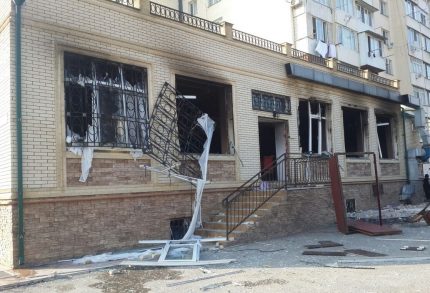
Gaskets improve performance gearboxes. The latter are connected when supplying gas through a hose to lower or stabilize the pressure.In the process, the usual indicator of 16-50 or the limit of 150-250 atmospheres reaches values from 1 to 16, and the probability of an explosion increases compared to the state when the balloon is not used. The sealant reduces the risk.
After prolonged use of the cylinders, the seals become deformed. They are changed about as often as cylinder taps.
In addition to sealing, with gas cylinders, transportation gaskets are used: rings are put on a wide part of the body, in 2 places.
Sealant Materials
In production, paronite, rubber and ftoroplast are used.
Due to the adhesiveness, paronite densely fills the gaps and gaps. The compounds are specially protected with graphite so that the material does not stick to them. Biological and climatic factors affect paronite weakly, and the sealant with mineral additives will survive after contact with aggressive hydrocarbons. If the ideal size of the washer is exceeded, the effect of it becomes minimal.
Rubber is used due to its elasticity, ability to restore shape. Amorphism and elasticity are also noted among the properties. The latter indicator increases with the temperature of the medium. Hardness is controlled by the degree of vulcanization, plasticizers and fillers.
Sealers are made of nitrile butadiene rubber with an upper temperature limit of + 120 ... + 130 ° C and fluororubber which can withstand up to + 150 ... + 200 ° C.
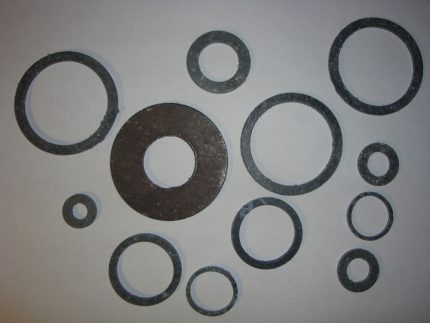
Ftoroplast is resistant to chemical and corrosive processes. The material also revealed weather resistance, heat and frost resistance. Due to the low gas permeability, fluoroplastic began to be used in private homes and gas pipelines. After a fire, it quickly damps, and the friction coefficient is in the range 0.4–0.05 at a load of 1–20 kgf / cm².
In practice, silicone profiles are also used, but general safety standards prohibit the installation of material on gas and fire equipment. Silicone reliably seals, exhibits high temperature resistance, but is highly flammable.
Range of sizes and models of gaskets
Gasket efficiency for gas bottle depends on its size and dimensions of the unit. In the case of shipping rings, the inner diameter should be slightly smaller than the diameter of the cylinder. For O-rings inside the joints, exact matching in size matters.
Washers for external structures are selected according to the outer and inner diameters. All types of gaskets are heavily loaded, so their compatibility with equipment depends on pressure indicators.
Rings for necks and reducers have a flat configuration. Their sizes are regulated GOST 15180-86. The document described the parameters of flat elastic gaskets made of PTFE, paronite, rubber and materials based on them. The standardized products are sealed with flanges and connecting parts, which are the elements of the valve of the gas cylinder and various fittings.

The size range of gaskets is correlated with nominal bore (DN, Du) in millimeters and nominal pressure (PN, Pnom, Ru) in MPa. Both indicators are also called nominal.
The first displays the internal diameter of the structural element along which the gas moves. Nominal pressure acts as a conditional indicator, which was established on the basis of strength calculations at a temperature of +20 ° C.
Dimensions of gaskets according to GOST:
| Nominal bore (DN), mm | Conditional pressure (PN), MPa | Outer diameter of gasket (D), mm | Gasket inner diameter (d), mm |
| 10 | 0,1 – 0,63 | 38 | 14 |
| 10 | 1,0 – 4,0 | 45 | 14 |
| 15 | 0,1 – 0,63 | 43 | 20 |
| 15 | 1,0 – 4,0 | 50 | 20 |
| 20 | 0,1 – 0,63 | 53 | 25 |
| 20 | 1,0 – 4,0 | 60 | 25 |
| 25 | 0,1 – 0,63 | 63 | 29 |
| 25 | 1,0 – 4,0 | 69 | 29 |
| 32 | 0,1 – 0,63 | 75 | 38 |
| 32 | 1,0 – 4,0 | 81 | 38 |
| 40 | 0,1 – 0,63 | 85 | 45 |
| 40 | 1,0 – 4,0 | 91 | 45 |
| 50 | 0,1 – 0,63 | 95 | 57 |
| 50 | 1,0 – 4,0 | 106 | 57 |
| 65 | 0,1 – 0,63 | 115 | 75 |
| 65 | 1,0 – 4,0 | 126 | 75 |
Shipping gaskets are used for transportation and storage.Rings protect the cylinder from damage and violation of the paint layer, impacts on other containers. Products for gas cylinders are produced in accordance with TU 2500-376-00152106-94. The peculiarity of these rings lies in the round section.
Some products:
- OH-1101: 25 ± 1.3, 215 ± 3.
- OH-1102: 25 ± 1, 210 ± 3.2.
- OH-2202: 15.6 ± 1, 285 ± 3.
- OH-3303: 25 ± 1.6, 140 ± 2.5.
The first indicator displays the diameter of the cross section of the ring in millimeters, the next - the inner diameter (mm). These products are used under normal external pressure and a temperature range of -40 ... + 40 ° C.
Sealing Requirements
The gasket must match the drawing. Offset of the form is allowed within the limits on the size indicated in special tables.
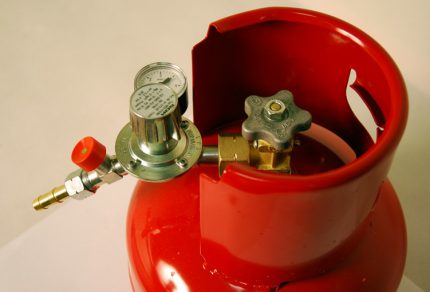
Washers with cracks, bubbles or porosity cannot be placed on work surfaces (P). In the case of non-working (HP), only gaskets with cracks are not used, and they make an exception for other parameters.
On both types of surfaces, it is possible to install gaskets with some defects if they do not exceed the permissible values:
- The imprint on the surface of the product. With depth, length and width acceptable for the size of the gasket.
- Chipped up to 0.3-1.5 mm long, depending on the thickness of the sealant.
- Extrusion height up to 0.3-1.5 mm. The value also depends on the thickness of the washer.
- Deepening, elevation and inclusion. Up to 0.3-5 mm.
- Underdevelopment. Up to 0.3-5 mm, based on the thickness of the gasket.
- Retracted edge. With a size of up to 0.3-1 mm.
Before installation, the gaskets are cleaned of dirt and dust and the target surface is prepared in the same way. Rings fasten without impact loads, with short stretching.
The condition of the gasket can be determined by the node in which it is installed. After changing the unit or removing the product itself, it is subject to further operation in the case of a constant appearance, maintaining dimensions.
Criteria also apply to gaskets and shipping rings for gas cylinders with propane of 2, 5, 10, 12, 15, 20, 27, 40, 50 liters or more. The norms cover articles for cylinders with methane of 47, 50, 67, 80, 85, 96, 100, 123, 132, 160 and 185 liters.
Gasket Replacement Procedure
Changing the o-ring on the neck of the housing often coincides with valve replacement. The gasket is updated if a problem is identified with it or the tap.

Valve replacement is resorted to if:
- unable to move the flywheel, it became more difficult to scroll;
- there is a deformation of the valve or its parts;
- the room smells of gas;
- scheduled technical inspection did not take place.
Gaskets change with the exact algorithm of actions. First, the cylinder itself is carried as far as possible from the buildings. The valve flywheel is slowly unscrewed, after which gas is released. The valve is carefully dismantled, smoothly and without damaging the body.
Remaining in the cylinder condensate is poured. Then there are simple technical steps: install a new gasket, another valve (if necessary). At the end, check for leaks.
Independent manipulations prohibit the rules, but in extreme cases and if you have the skills, you can not wait for specialists. Some types of valves can be partially disassembled indoors and without venting gas, for example, to replace internal oil seals.
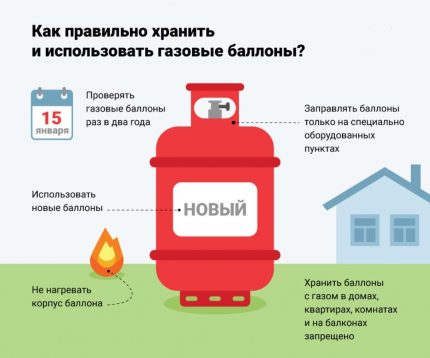
Replacing the gasket between the valve and gear takes less time.It will be enough to close the flywheel, disconnect the gearbox and install a seal between its nut and the valve fitting.
Some gearboxes do not work through the valve, but directly from the cylinder. In this case, it should be taken to the street to release gas.
Conclusions and useful video on the topic
Resolving gas leaks using improvised tools and replacing the valve’s inner gasket:
Sealing elements on gas cylinders should be changed at the first sign of damage or loss of tightness. They are made from non-flammable materials like paronite, fluoroplastic and special rubber. Rings are available for containers and assemblies of any size, so there is no doubt about the quality of the seal.
Household goods stores have gaskets for gas cylinders of 12, 27, 50 liters and containers with less common sizes. The cylinders themselves should be stored outside residential buildings, apartments and technical floors, away from escape routes.
Write comments on the topic of the article, ask questions, share important information. If you bought a gasket for a gas cylinder, tell us what material you purchased the product from and whether you are satisfied with its quality. The communication unit is located below.

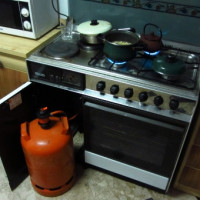 Is it possible to keep a gas cylinder in an apartment: rules and regulations for the use of balloon gas
Is it possible to keep a gas cylinder in an apartment: rules and regulations for the use of balloon gas 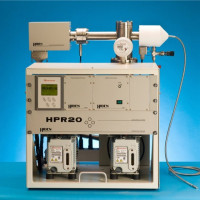 Gas analyzer: principle of work, what to look at when choosing + manufacturers review
Gas analyzer: principle of work, what to look at when choosing + manufacturers review 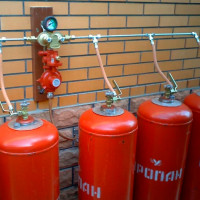 How to use a gas cylinder in your home: instructions + valuable tips
How to use a gas cylinder in your home: instructions + valuable tips  What to do if a gas stove passes gas: causes of gas leakage and their elimination
What to do if a gas stove passes gas: causes of gas leakage and their elimination 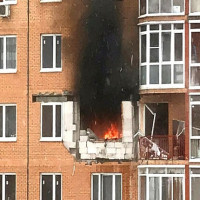 Why gas cylinders explode: root causes and preventive measures
Why gas cylinders explode: root causes and preventive measures  Actions for the smell of gas in the boiler room: what to do when a characteristic odor is detected
Actions for the smell of gas in the boiler room: what to do when a characteristic odor is detected  How much does it cost to connect gas to a private house: the price of organizing gas supply
How much does it cost to connect gas to a private house: the price of organizing gas supply  The best washing machines with dryer: model rating and customer tips
The best washing machines with dryer: model rating and customer tips  What is the color temperature of light and the nuances of choosing the temperature of the lamps to suit your needs
What is the color temperature of light and the nuances of choosing the temperature of the lamps to suit your needs  Replacement of a geyser in an apartment: replacement paperwork + basic norms and requirements
Replacement of a geyser in an apartment: replacement paperwork + basic norms and requirements